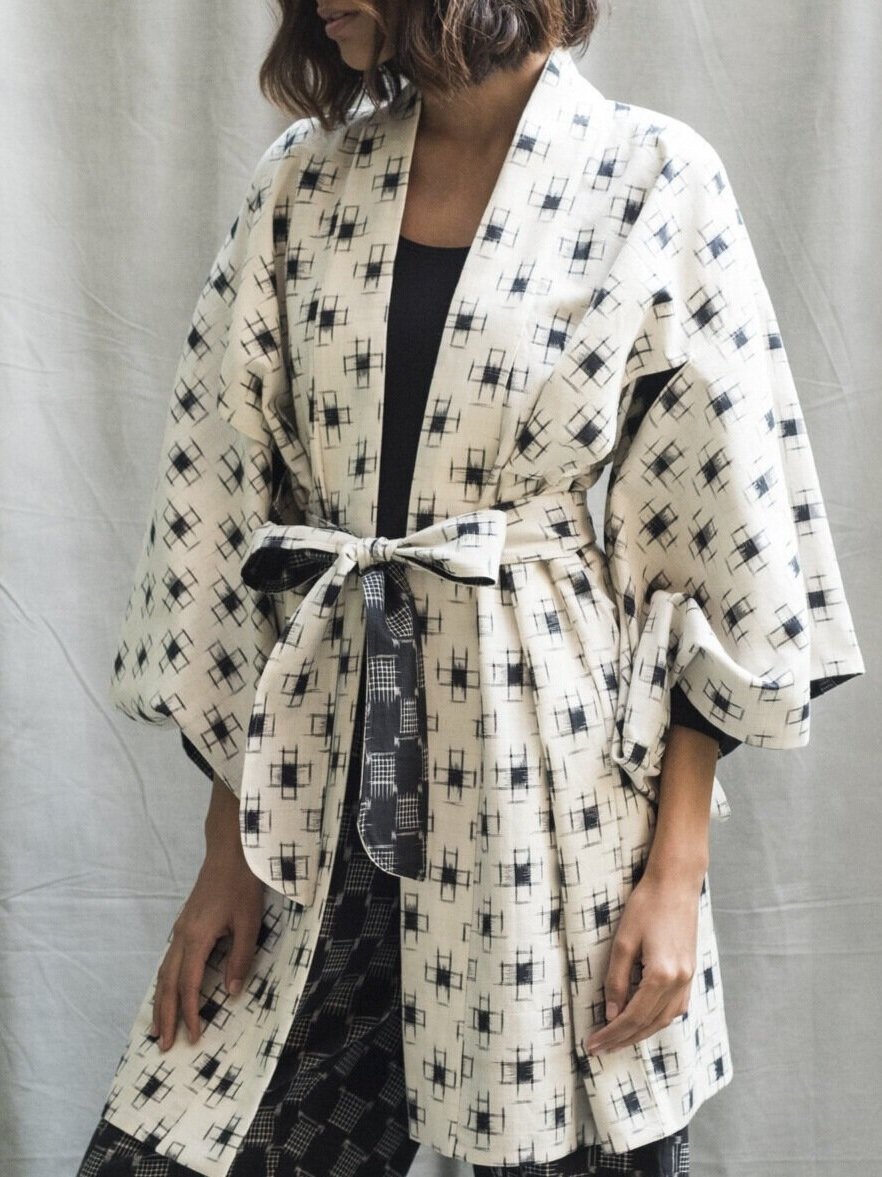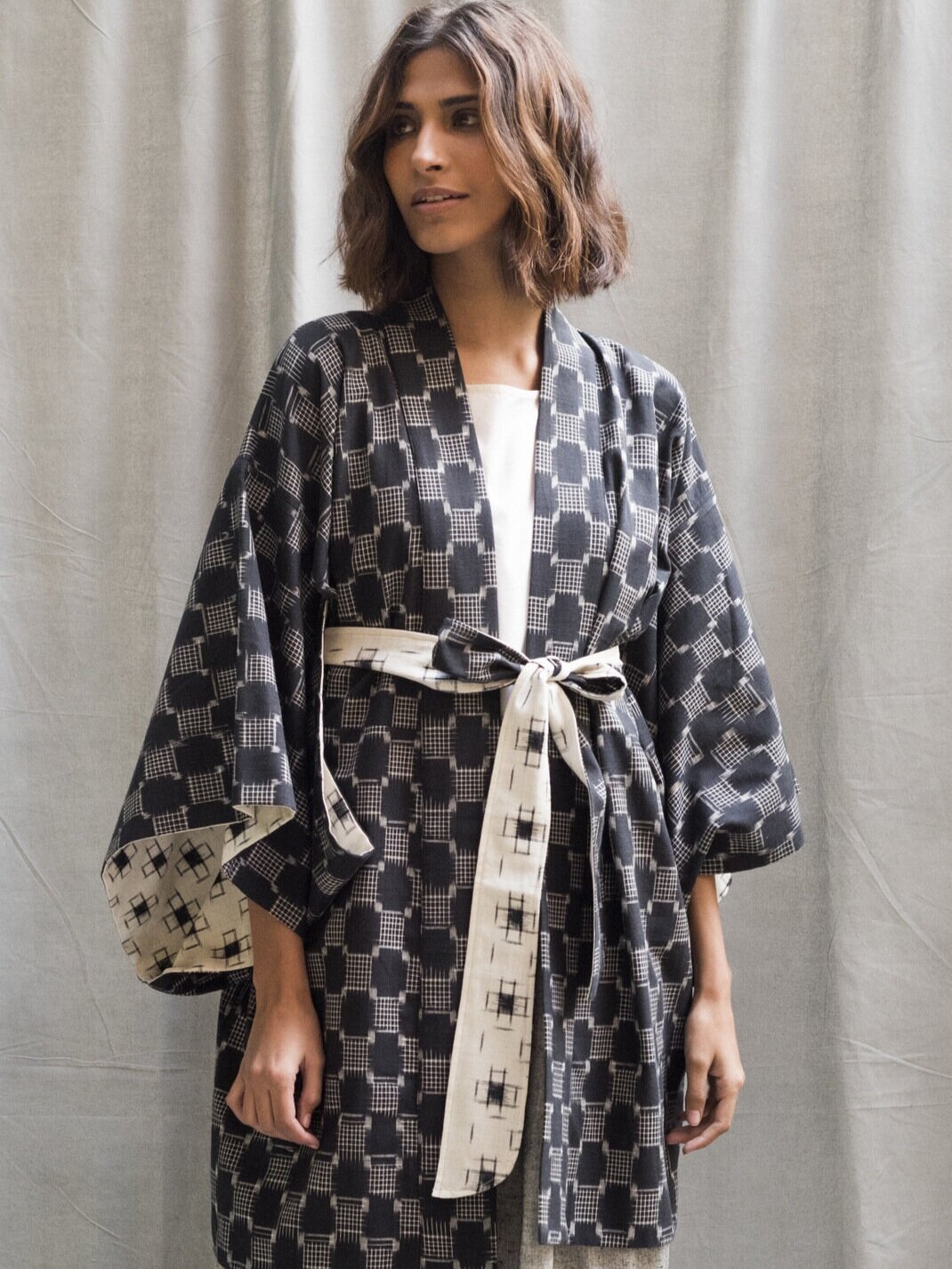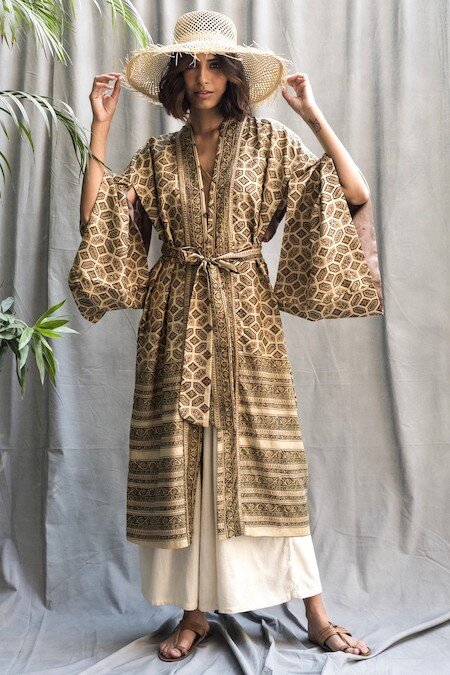The Ultimate Guide to Our Sustainable Kimono Robes
Ikat Cotton Kimono Robe in Ivory
A deeply symbolic garment that has defined Japanese style over generations, the kimono has captivated and inspired many. Today it’s a fashion statement that has been reimagined to become a wardrobe staple that’s versatile, flattering and stylish. Our collection of sustainable kimono robes are no exception. Combining the iconic design of a traditional T-shaped kimono with the heritage textiles of India, our kimonos combine authenticity with wanderlust fabrics that are a joy to wear.
In this guide to sustainable kimono robes, I’m showcasing our new collection of cotton kimonos and taking you on a journey behind the scenes to show you how our kimonos are ethically made and what makes them so special. Plus there’s lot of style tips on how to style them.
Cotton Kimono Dressing Gown in Charcoal
Introducing Our New Collection of Ikat Cotton Kimono Robes
Concept
Autumn is here and we’re so excited to launch a whole new collection of cotton kimono robes. This collection combines timelessness and simplicity through its neutral colour palette, yet celebrates complex Ikat patterns merged into beautifully handwoven fabric. This range of short, easy to wear kimono dressing gowns is a nostalgic nod to Mingei - loosely translated as folk craft or ordinary peoples craft. It is the concept of universal beauty expressed through simplicity. Finding joy and beauty in everyday things made by everyday people. It’s a counter argument you could say to the modernisation of the textile industry. As an artisan fashion brand, we’re all about celebrating the beauty of the handmade and age old craft techniques. So for us it’s about appreciating beauty in the ordinary created by the unknown artisans.
How our cotton kimonos are made
Handwoven by a group of specialised Ikat master artisans in Hyderabad, India - Ikat is an ancient dyeing and weaving process found in many countries around the world. It’s the process of resist-dyeing yarn that has been meticulously tied with string in specific locations, then dyed. This results in tied areas resisting the dye. The fabric of our short kimono robes is a double Ikat - a complex process that means both the weft and warp yarns are dyed and must line up during weaving. Only a few places in the world create double Ikat, so it’s a sought after design process that’s much revered.
Whilst our upcycled sari kimonos are bright and colourful, this collection is neutral and focusses on traditional Japanese Kasuri Ikat, which has blurred edges of patterns in geometric designs. Available in two colours - Ivory and Charcoal, these kimonos will effortlessly coordinate with your outfits.
What to Wear With A Kimono
Blending the best of Japan and India, our kimonos have a timeless silhouette of the traditional Japanese kimono, crafted in India's finest textiles. They’re the ultimate loungewear with a comfortable fit and soft cotton that drapes easily around the body allowing you freedom of movement. Truly versatile these will become one of those wardrobe staples that feel good to wear whether you’re relaxing at home, having Sunday brunch or out and about day or night. Celebrating neutrals, you can literally wear anything with them. We suggest jeans and a t-shirt top for a casual look, elevated with heels and accessories. Tonal colours and neutrals add impact as well as flowing skirts and trousers. See below for more ideas on how to style our kimonos.
The perfect Autumn clothing, the cotton has a mid-weight feel to it for those cooler days, a fabric sash to cinch in the waist for shape, and a relaxed silhouette that fits a small to large size. A great tip for coordinating your clothes with the kimono is to tie the kimono belt to your dress or trousers.
Impact:
Ethically made by artisans all our kimono gowns empower artisans to a fair and sustainable income, enabling men and women to better their lives and achieve economic independence. Preserving crafts, preserves craft communities who frequently struggle to make a living in a world of mass production. Increasing awareness and celebrating heritage crafts to a global community means customers own ethically made, unique items of clothing they can cherish for years.
Handmade Silk Kimono Made From Recycled Saris
Silk Kimono Robes
Our silk kimonos are small batch, limited edition collections of kimono loungewear that combines style, comfort and the beauty of upcycled silk saris. Only the finest silk saris are handpicked to create these beautiful kimono robes. Fusing the best of Japan and India, they combine the timeless silhouette of a traditional Japanese kimono, with the finest preloved Indian silk saris.
Mini showing off her saris
How our handmade silk saris are made
Working with a social enterprise in India, our silk kimonos start off as a sari. Sourced from sari traders in the colourful bazaars of Delhi, only the finest saris are handpicked for their quality, colour and beautiful designs. Once chosen they go through a series of quality control stages where they are checked for defects and cleaned. Beautiful on the inside and out, our silk kimono dressing gowns are reversible, so one length of sari is coordinated with another, cut into a traditional kimono design and stitched by skilled artisans, two brothers Parvez and Lal.
A bhandiwali collecting preloved saris in India
Wondering how preloved saris end up in the markets of Delhi? As the national dress of the Indian sub-continent, the sari is a cultural statement that has stood the test of time when it comes to fashion. Infinitely versatile, this iconic wardrobe essential is handed-down over generations, gifted on special occasions or repurposed to make Kantha quilts or other household items. In addition the age-old tradition of bartering saris in exchange for utensils still exists. When a woman wants to recycle her saris, she calls for a "bhandiwali" in her area who will trade the sari for utensils such as pots and pans. Bhandiwalis, then travel to the bazaars in cities and towns to sell these saris on to traders. This is where the journey of our vintage silk kimonos starts.
Orange Silk Kimono Robe
How to Style a Kimono 5 Ways
If you think a kimono is just a posh bathrobe - think again. Our kimonos are multi-functional, which means you get a versatile piece of clothing that won’t just sit in your wardrobe gathering dust! Here’s five ways to wear a kimono robe.
1) Wear a kimono as loungewear.
There’s nothing like lounging in a silk kimono dressing gown in the evening or at weekends. It’s the ultimate cover up that adds a touch of glamour to your everyday. Our long silk kimonos are perfect to wear while you’re getting ready to go out or staying in. Not only do they help you look and feel beautiful, they’re lightweight and more flattering than a fluffy cotton dressing gown.
2) Wear your silk kimono with a t-shirt and jeans
Throw over your favourite plain white tee, jeans and flats or smart sneakers.
3) Going “out out” style that’s coordinated and thoughtfully put together
Floral silk kimono robe in pink and blue
Top to toe, tonal colours add sophistication. Match trousers, a top and shoes in tones that fall within the same colour as your kimono robe. If your kimono is multicoloured, go with the most prominent colour and coordinate around that. Remember our kimonos are reversible so they’re great for adding versatility to your outfits and wearable through out the year.
A kimono robe is versatile holiday must have
4) Summer staples at home or away
Our sari silk kimonos are essential holiday staples. Throw over a one-piece swimsuit or bikini for in between beach to bar moments. Perfect for travel, these silk kimono robes fold small and flat in your suitcase when space is a premium. Wear around the pool or throw over loose fitting trousers, paper bag shorts or a dress for evening soirees and strolls on the beach.
5) Dress up a dress down look with a vintage silk kimono
If you’re looking to elevate a casual look into an evening out, a kimono is an instant style statement. Add heels, statement earrings and a cute bag to your jeans and t-shirt ensemble for a spontaneous date night or meeting friends.
Frequently asked questions you may have
One question you may have is how to wear a kimono if you’re short? In fact can you wear a kimono if you’re short? The answer is of course yes. I would recommend you choose our new range of kimonos robes as they are short in length. But if you love the sari kimonos then there are a few things you can do to give the illusion of being taller than you are. Here’s a few style tricks to make you look taller:
1) Wear your hair in a top bun and add heels. This creates the illusion of length by guiding the eye from the top to the bottom.
2) Wear high waisted trousers or jeans to make you look like your waist is higher
3) Wear nude shoes - these not only look chic but lengthen the leg. Pointed shoes have the same effect.
4) Wear clothes that are tailored and fit well. Loose clothes drown you but if you’re wearing a a dress, add a belt to add shape.
But what’s the difference between the new collection of cotton kimono dressing gowns and the upcycled sari kimonos?
To start with the new collection is made from cotton and short in length. So you’ll have to decide if you want a short kimono in cotton or long silk sari kimono. The new collection is neutral whereas the upcycled sari collection of kimonos are for those who love colour in their wardrobe. Both celebrate the authenticity of a t-shaped Japanese kimono.
Your impact when you buy an upcycled sari silk kimono
Upcycled clothing is one of the most sustainable fashion practices. Aptly named as “creative recycling” upcycling takes products that would normally have been thrown away and transforms them into something new. That means saris that may end up in landfill are given a new lease of life. The product life is extended and you end up with something beautiful that’s ethically made by artisans who earn a sustainable income.
I hope you found the stories behind our collection of kimonos fascinating and that this guide was helpful. Comment below if you have any questions and tell us what you think about the new collection.









